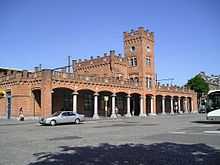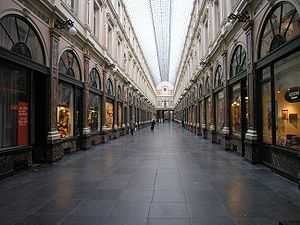Jean-Pierre Cluysenaer
| Jean-Pierre Cluysenaer | |
|---|---|
| Born |
28 March 1811 Kampen, The Netherlands |
| Died |
16 February 1880 Brussels, Belgium |
| Nationality | Belgian, |
| Buildings | Galeries Royales Saint-Hubert |


Jean-Pierre Cluysenaer was a Belgian architect. He was born in Kampen in the Netherlands as a descendant of a Dutch family of architects and engineers. During the United Kingdom of the Netherlands his family settled in the southern Belgian provinces. Cluysenaar studied architecture at the Académie Royale des Beaux-Arts in Brussels under Tilman-François Suys. His teacher influenced him in his preference for the architecture of the Italian Renaissance.
Cluysenaer had a talent for business. He took the initiative for some very profitable real estate projects - such as the Galeries Royales Saint-Hubert in Brussels - in which he played the double role of architect and co-financier. He also had a good reputation amongst the Belgian nobility and high bourgeoisie. He received many commissions for designing large town houses (so called "Hôtels"), Mansions and château's. He was always prepared to adapt his designs to the desires and taste of his elite patrons. The many private mansions he built greatly differ in style. Cluysenaer designed elegant Palladian villa's as well as more sturdy Gothic Revival castles.
His stylistic versatility is also apparent in the many public buildings he designed such as the Neo-Renaissance, Koninklijk Conservatorium/Conservatoire Royal in Brussels and the "Tudor style" railway station in Aalst.
Jean-Pierre Cluysenaer was the father of the painter Alfred Cluysenaer. He was also the grandfather of architect Paul Saintenoy who was a son of Cluysenaer's daughter Adèle and the architect Gustave Saintenoy.
List of works
A brief selection of the more than 200 projects in which Cluysenaer was involved:
"Châteaux" and other private residences
- "Hôtel" of baron Brugmann, rue d’Arenberg, Brussels (1844)
- "Hôtel Nagelmackers", Liège (1846)
- Château "de Bavay", Vorst (1851)
- Château Rey, today town hall of Drogenbos (1852–1853)
- Château of comte Ferdinand de Meeûs in Argenteuil near Waterloo (1856–1858)
- Hôtels de Meeûs, square Frère-Orban in Brussels (1861)
- Château of Baron de Viron, todat town hall of Dilbeek (1862)
- Château of Vieux-Sart, Corroy-le-Grand (1864)
- Mansion of the violoncellist Adrien-François Servais in Halle (1859)
public buildings
- "Kiosque" in the park of Brussels (1840)
- Galeries Royales Saint-Hubert, shopping arcade, Brussels (1845–1847)
- Concert Hall in Aachen, Germany (1846)
- "Panorama de la rue Royale" stairs and terraces surrounding the Congress Column, Brussels, 1847 (demolished)
- Marché de la Madeleine (Magdalenamarkt) covered market, Brussels (1847) (partly demolished)
- Galerie Borthier, shopping arcade, Brussels (1848)
- Railway stations for the "Société Dendre et Waes" in: Ternat (1856), Aalst (1856), Zandbergen (1860).
- "Hôpital des Aveugles", (home for blind people), Porte de Hal/Hallepoort, Brussels (1852).
- "Église de fer" (iron church) in Argenteuil (Waterloo) (1855–1862).
- Theatre and "Kurhaus" in Bad Homburg (1851, 1862–1866)
- Royal Conservatory of Brussels, rue de la Régence/Regentschapsstraat, Brussels, (1872–1876)
References
Fanny Cluysenaer (Madame Veuve Henry Heymans), Les Cluysenaar: une famille d’artistes, Brussels, Weissenbruch, 1928.
| Wikimedia Commons has media related to Jean-Pierre Cluysenaar. |
